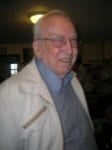SHORT FINAL By DEB McFARLAND
 Pickens County Airport in Jasper, Georgia, is a nice airport, but it’s not particularly known as a hub of aeronautical excitement. However, every now and then we have a visitor who attracts notice. Such was the introduction of pilot and veteran, Jesse William Lankford Jr., who recently attended our annual Christmas dinner.
Pickens County Airport in Jasper, Georgia, is a nice airport, but it’s not particularly known as a hub of aeronautical excitement. However, every now and then we have a visitor who attracts notice. Such was the introduction of pilot and veteran, Jesse William Lankford Jr., who recently attended our annual Christmas dinner.
Lankford was born in France in 1918 while his father was based there during World War I. As one of the new veteran pilots, the elder Lankford returned to the United States to work for the Bureau of Standards under the Department of Commerce. In this capacity, he assisted in establishing the requirements for the private pilot license. His own history and training in World War I earned him license number 41. When he retired some years later, he was the safety bureau director of the Civil Aeronautics Board.
It is not surprising that the father’s love of aviation was passed on to the son. Lankford quite simply felt flying was “part of his life,” so in 1940, he ignored his father’s advice to wait until his college education was completed and began lessons in a Piper Cub. At the time, the U.S. government offered a program to boost the economy at little airports. An applicant could learn for fly for $35. Young Jesse worked at a local grocery store on the weekends to earn money for the program.
He took that new license and joined the U.S. Air Corps in 1941. For the first year and a half, he flew submarine patrols from Fort Dix to Maine in the North American O-47, an airplane he considered obsolete even when new. A three-seater observation plane used in the late 1930s and early 1940s, it was not the most glamorous airplane or duty for a young pilot. He later transitioned to the B-25, flying escort, for less than a year until he ended up in a place where pilots felt like a “forgotten aside” of the war. He was sent to Burma to fly the Hump.
In 1942, the Japanese overran Burma and cut off the last major land-based supply routes from India that supplied China. The alternative to supplying Chinese troops was a 530-mile route over the Himalayan Mountains that became known as “Flying the Hump.” From 1942 until the Burma Road between India and China was reopened in 1945, almost 1,000 men and 600 airplanes were lost.
Working with the British 14th Army, a coalition of units from the British Commonwealth, Lankford flew the C-46 with no armament. “Thank God for the Flying Tigers!” was one of the most emotional comments he made as we spoke. At the time, he was in his 20s, flying from jungle to jungle where only mules could travel over one of the most intimidating mountain ranges in the world. The Curtiss-Wright C-46 Commando was the largest and heaviest twin-engine aircraft in the Air Corps. Because of its higher altitude capabilities, the Whale was better suited for flying heavy cargo over the Hump.
“It was like we were on our own,” he recalls, and research reiterates this sentiment. “Forgotten Army,” the “Forgotten War” and the “Forgotten Front” are common descriptions about this campaign and its participants.
Jesse William Lankford Jr. no longer had to fuel his imagination through his father’s achievements or with the feats of his idol, the World War I ace, Eddie Rickenbacker. He had experiences and recollections that were all his own.
When Lankford stepped out of service in 1945, he stepped into the cockpit of an Eastern Airlines airliner. DC-3, Martin 202/404, Convair, Lockheed Constellation, Lockheed 188, DC-4, DC-6, and the 727 are just some of the type ratings that appear on his license which, by the way, is also number 41. That’s right. It’s the same as his dad’s because it is his dad’s. When the elder Lankford decided his flying days were over, he transferred his number to his son.
Lankford spent the next 33 years fulfilling his dream of flying with the airlines. He retired at 60 and seldom flew thereafter.
Deb McFarland is the proud owner of Lester, a 1948 Luscombe 8E, and part of the “Front Porch Gang” at Pickens County Airport in Georgia. She can be reached at [email protected].
